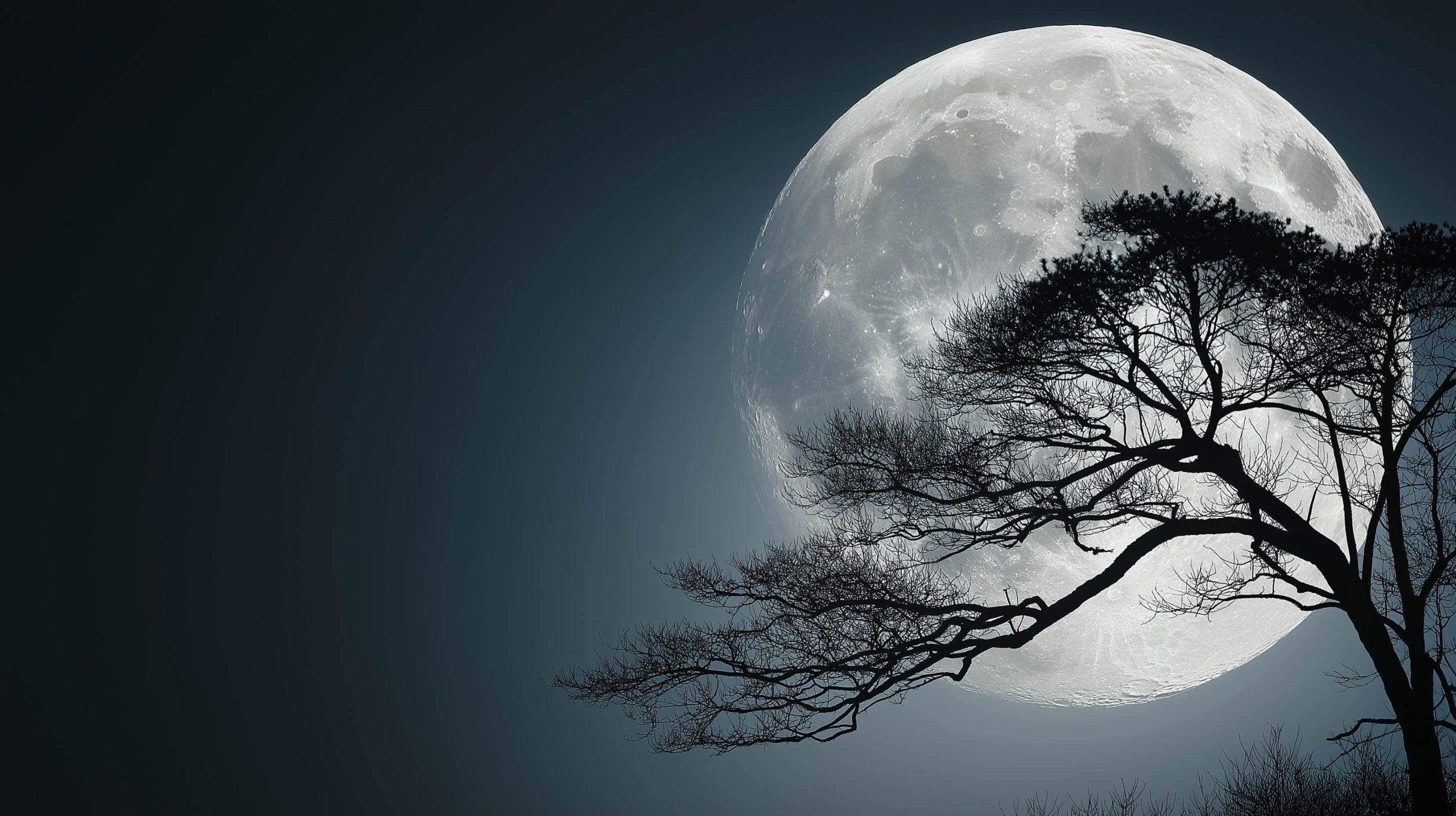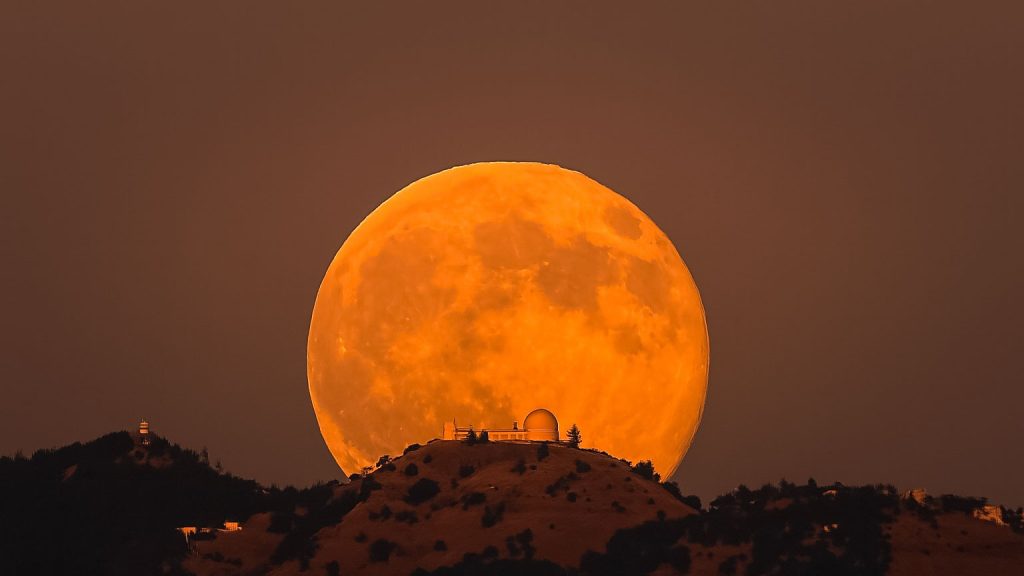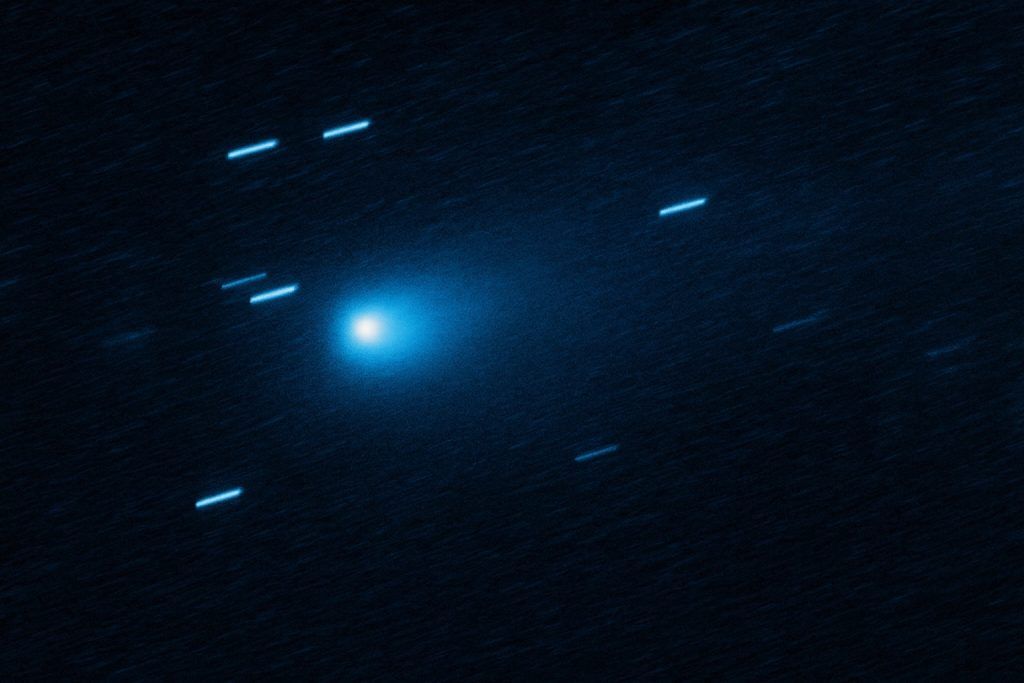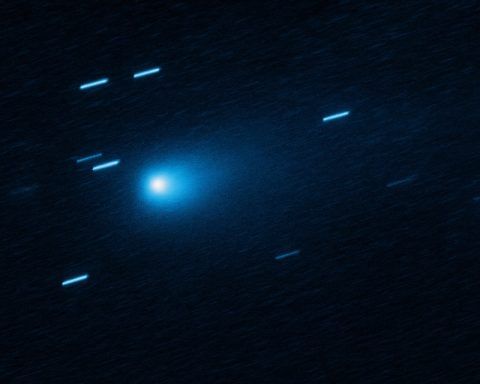- Year’s Brightest Full Moon: The Full Beaver Moon on November 5, 2025 is a supermoon – the closest full moon of the year – making it the largest and brightest moon of 2025 [1] [2]. It reaches peak illumination at 8:19 a.m. EST (1319 GMT) on Nov. 5 [3], though it will appear full on the nights of Nov. 4 and 5.
- “Beaver Moon” Origins: November’s full moon is called the Beaver Moon from traditional lore – it marks when beavers hunker down in their lodges for winter and when trappers historically set traps for their thick winter fur [4] [5]. Other cultures have their own names (e.g. Cree “Freeze-Up Moon,” Cherokee “Trading Moon,” etc.) reflecting seasonal changes [6].
- Supermoon Explained: A supermoon occurs when a full moon coincides with the moon’s closest approach to Earth (perigee) in its elliptical orbit [7] [8]. This makes the moon appear about 7–14% larger and 15–30% brighter than a typical full moon [9] [10] – though the difference can be subtle to the naked eye. November’s Beaver Moon comes only ~221,700 miles (356,800 km) from Earth [11], versus ~238,900 miles on average.
- Consecutive Supermoons: This Beaver Moon is the second in a trio of late-2025 supermoons, and the closest moon in nearly 9 years. We won’t see a full moon this big and bright again until November 2026 [12]. It follows October’s Harvest Moon supermoon and will be slightly brighter than the upcoming December Cold Moon [13].
- Taurid Meteor “Fireballs”: The Southern Taurid meteor shower peaks the night of Nov. 4–5, 2025, coinciding with the full moon [14]. The Taurids are a minor shower (~5 meteors/hour) but known for occasional bright fireballs. 2025 is predicted to be a “swarm year” with enhanced fireball activity, potentially doubling the usual rates [15] [16]. However, the supermoon’s bright light will wash out most faint meteors, so only the brightest fireballs may be visible [17].
- Viewing Tips: For the best skywatching: catch the moonrise on Nov. 4 or 5 just after sunset for a dramatic oversized, golden moon on the horizon [18]. Meteor hunters should try after midnight until dawn on Nov. 5, when the moon is lower and Taurid fireballs stand out against the dark sky [19]. Find a dark location away from city lights, and give your eyes ~20–30 minutes to adjust to the darkness for optimal viewing [20] [21]. No telescopes are needed – just look up and enjoy the show!
What Is the Beaver Moon and Why Does It Matter?
Each month’s full moon carries a traditional name tied to seasonal rhythms. November’s full moon is widely known as the “Beaver Moon.” According to the Old Farmer’s Almanac, this name harkens back to a time when beavers finish preparations for winter – gathering food and retreating to their lodges once ponds start to freeze [22]. It was also the prime season for trappers in North America to catch beavers for their thick winter pelts during the fur trade era [23]. In other words, the Beaver Moon signaled an important period of pre-winter activity for both wildlife and people, hence “why it matters” in a cultural and historical sense.
Not all cultures use the “Beaver Moon” name, but nearly all have traditional moon names marking the seasons. Many Indigenous American tribes named each full moon based on natural events or animal behavior that month [24]. For example, the Cree called November’s moon the Freeze-Up Moon as temperatures plunged [25], and the Cherokee referred to it as the Trading Moon for the post-harvest trading season [26]. In parts of Europe it was sometimes called the Frost Moon or Snow Moon, reflecting the onset of winter [27]. The common thread is that November’s moon heralds the transition into winter – a time to take stock, gather provisions, and prepare for the cold.
Today, these traditional names provide a fun cultural touchstone that connects us with nature’s cycle. The Beaver Moon might not have scientific significance per se, but it’s a reminder of seasonal change and our ancestors’ close relationship with the environment. Even in modern times, news outlets, skywatchers, and social media eagerly talk about the Beaver Moon each year, keeping the old naming traditions alive. As two scholars of Native American lore explain, such moon names encapsulate the “activities of animals, birds and fish” and seasonal changes, varying by region and ecology [28]. In short, the Beaver Moon matters because it carries rich cultural history – and this year, it comes with an extra twist: it’s also a dazzling supermoon event.
November 2025 Supermoon – The Biggest and Brightest Full Moon of the Year
This November’s full moon isn’t just any full moon – it’s an official supermoon, and in fact the brightest full moon of 2025 [29] [30]. The term “supermoon” has become popular shorthand for a full moon that appears larger and brighter than usual because the moon is at or near its closest point to Earth in its orbit at the same time it’s full [31] [32]. In scientific terms, the moon is at perigee (the nearest point in its elliptical orbit) while being 100% illuminated by the Sun.
How much “super” is this supermoon? Thanks to the moon’s elliptical path, the distance between Earth and the moon varies each month. On average the moon is about 238,900 miles (384,000 km) away, but on November 5 it comes to around 221,700 miles (~356,800 km) from Earth [33] – nearly 17,000 miles closer than average. That difference in distance makes the moon appear slightly larger and brighter: roughly 7–8% larger in diameter and about 15% brighter than a typical full moon [34] [35]. Compared to the smallest full moons (those occurring at the farthest distance, called “micromoons”), this supermoon looks up to 14% bigger and 30% brighter [36].
In practical terms, an extra 7–14% in apparent size is fairly subtle – a casual observer might not notice a huge difference without a side-by-side comparison. “While a supermoon can appear up to 14% larger and 30% brighter, experts say the visual difference may be subtle to the naked eye,” astronomer Dr. Catherine Pilachowski notes. The moon won’t suddenly look like a giant disk, but many people do report it looking especially luminous and large when it’s near the horizon. In fact, the brightness is unmistakable on a clear night – a supermoon’s glow can even cast faint shadows on the ground at its peak, a rare effect only seen during the most intense full moons [37]. November’s Beaver Moon is expected to be so bright that its moonlight will wash out faint stars in the sky [38].
This particular supermoon stands out because it’s the closest full moon of the year [39]. It’s actually the biggest, brightest Moon in years – skywatchers note the Moon hasn’t come this close since 2019, and it won’t again until late 2026 [40]. It’s also noteworthy that this Beaver Moon is the second in a series of three consecutive supermoons closing out 2025 [41]. (October’s full moon was also a supermoon, and December’s will be as well, though slightly farther away and dimmer [42].) Because the full phase happens almost exactly at perigee this month, the November 5 moon is about as “super” as they get – a near-perfect alignment that maximizes brightness [43]. As National Geographic describes, the moon reaches peak fullness almost simultaneously with its closest approach to Earth, creating ideal conditions for a spectacular supermoon display [44].
Astronomers emphasize that despite the media hype, a supermoon is fundamentally the same Moon we see all the time – just a bit closer. “Even though 14 percent doesn’t make a big difference in detectable size, a full supermoon is a bit brighter than other moons throughout the year,” NASA notes on its Moon science page [45]. In fact, the term “supermoon” itself only dates back to 1979 (coined by an astrologer) and isn’t an official scientific term [46]. Some astronomers prefer to call it a perigee full moon and have quipped that “supermoon” can be more of a media buzzword [47]. Nonetheless, the public loves the concept – and there’s no denying the wow factor of seeing an extra-brilliant full moon lighting up the autumn sky. This Beaver Moon supermoon will be so bright that, as one planetary scientist noted, it could even “cast faint shadows” and outshine many stars until dawn [48] [49]. It’s truly a celestial highlight of 2025.
Why Do Supermoons Occur? The Science of Lunar Perigee
To understand supermoons, let’s dig into a bit of lunar orbit science. The Moon orbits Earth in an ellipse, not a perfect circle. This means sometimes the Moon is closer to us (at perigee) and sometimes farther away (at apogee). The difference is significant – at perigee, the Moon can be about 356,000 km away, whereas at apogee it’s around 406,000 km away [50]. When a full moon happens to occur during the close point (or within ~90% of the closest distance), we get what’s popularly called a supermoon [51].
Visually, a perigee moon’s disc size is a bit larger than an apogee moon’s. NASA explains that at its nearest, a full Moon looks up to 14% bigger and 30% brighter than at its farthest [52]. However, our eyes have a hard time judging the Moon’s size without context, so the increase isn’t dramatically obvious when the Moon is high overhead. It is more noticeable right at moonrise, when the Moon is viewed against familiar foreground objects – an effect known as the “Moon illusion,” where our brain perceives the low moon as enormous [53]. (That’s an optical illusion – the Moon isn’t actually larger on the horizon, but it certainly looks that way.)
Apart from apparent size, brightness is where supermoons truly stand out. A full supermoon can be around 15–16% brighter than an average full moon [54]. Many observers will notice the landscape illuminated more than usual on supermoon nights – it’s almost like mild twilight. “The glow of the moon will even cast faint shadows on the ground, a rare effect visible only during the most intense supermoons,” reports National Geographic [55]. That extra brightness is a direct consequence of the Moon being closer, so more lunar light reaches Earth.
Do supermoons have any physical effects on Earth? Slightly, yes – the Moon’s gravity pulls on our oceans to produce tides, and a closer moon means marginally higher tides. These are often called “perigean spring tides.” However, the difference is modest. Scientists at Royal Museums Greenwich note that a supermoon might raise tides just a few inches higher than a normal full moon [56]. “It does have an effect on Earth… it can cause higher tides than usual,” confirms NASA, but again it’s not a dramatic change [57]. So there’s no need to worry about floods or strange behavior – the “super” influence is mostly about skywatching enjoyment.
In short, supermoons occur because of the Moon’s elliptical orbit and the timing of the full moon phase. It’s a lovely alignment of orbital mechanics that gives us a periodic chance to see our nearest celestial neighbor a bit bigger and brighter than usual. And when the closest full moon of the year arrives – as it does this week – it becomes a special occasion for astronomers and the public alike.
Quote from expert: “You won’t notice the moon looking much bigger in the sky. But you will notice it’s brighter!” says Deborah Byrd of EarthSky, noting this November’s full moon is the brightest moon of the year and will have a “strong pull on earthly tides” (albeit nothing extreme) [58] [59]. The advice from astronomers is to enjoy the spectacle but keep expectations realistic – the difference is there, just not as cartoonishly large as the word “supermoon” might suggest.
Southern Taurid Meteor Shower: Fireballs vs. the Full Moon
As if a brilliant supermoon weren’t enough, the cosmos is offering a two-for-one show in early November. The annual Southern Taurid meteor shower is peaking on the night of Nov. 4–5, right as the Beaver Moon shines at its fullest [60]. The Taurids are a long-running meteor display that occurs each fall as Earth passes through debris left by Comet 2P/Encke. This meteor stream is known for being sparse but occasionally spectacular – Taurids usually produce only ~5 meteors per hour under dark skies [61], but they have a reputation for unusually bright, slow-moving meteors called fireballs that can streak dramatically across the sky [62].
In fact, 2025’s Taurid shower is anticipated to be one of those “fireball swarm” years. Astronomers at the American Meteor Society (AMS) have noted that in certain cycles (notably 2008, 2015, 2022, and now 2025), Earth encounters a denser patch of cometary debris, resulting in more frequent fireballs than usual [63]. This year, during the final week of October into early November, skywatchers have been on alert for an uptick in bright meteors. The predicted peak for the Southern Taurids is around 13:00 UTC on November 5 (early morning hours of Nov. 5 in North America) [64]. The Taurid shower doesn’t have a sharp peak – it “rambles along” for weeks [65] – but late October to early November is when activity from both the Southern and Northern Taurid branches overlaps, boosting the chances of sightings [66].
What can we expect this week? Under ideal conditions with no moon, observers might normally catch ~5–10 Taurid meteors per hour at the peak [67]. In a swarm year, the fireball rate can double, meaning perhaps up to 10+ meteors/hour if you’re lucky [68]. Some of these could be exceptionally bright – past Taurid swarms have produced meteors that outshine Venus and even light up the ground. However, there’s a big catch in 2025: moonlight. Unfortunately for meteor lovers, the full supermoon will be flooding the sky with light on the very night of peak Taurid activity. The Southern Taurids will be “sharing the sky with the Super Beaver Moon – the biggest and brightest of the year”, as Travel + Leisure notes, which “will likely wash out all but the most luminescent Taurids.” [69] In plain terms, the full moon’s glare will make it impossible to see the many faint shooting stars; only the brightest fireballs have a chance to stand out.
That said, those fireballs are what the Taurids are famous for! Even with the moon up, a truly bright meteor will streak past the glow. Taurid meteors tend to be slow-moving (relative to other showers) and often colorful, which makes them easier to spot if they occur [70]. If you’re patient and have dark enough skies, you might catch one of these spooky “Halloween fireballs” zooming from the constellation Taurus (near which the meteor paths appear to originate). Fireball meteors from the Taurids can be breathtaking – some observers in past swarm years recall seeing bolides that broke into fragments or left lingering trails of ionized gas.
It’s also worth noting that the Northern Taurid branch peaks about a week later on November 11–12, when the moon will be a waning crescent and much less obtrusive [71] [72]. So if the Beaver Moon blinds out the Southern Taurids, stargazers can try again for the northern component under darker skies in mid-November. Additionally, the famous Leonid meteor shower occurs later in the month (around Nov. 17–18) and will benefit from minimal moonlight this year [73]. In essence, November 2025 is full of meteor activity – but the first show (the Southern Taurids) comes at a bright lunar moment.
Meteor Shower at a Glance:
- Peak Timing: Night of Nov. 4–5, with best viewing after midnight once Taurus is high in the sky [74] [75]. Activity continues at a lower level for days before and after.
- Fireball Potential: High – 2025 is a swarm year, so watch for extra-bright meteors. Some Taurid fireballs may rival the Moon in brilliance for a brief moment! [76] [77]
- Moon Interference: Extreme – a 100% full supermoon will significantly reduce visible meteor counts. Expect only the brightest meteors to be visible [78].
- Viewing Tip: Focus on quality over quantity – hope to catch one or two spectacular fireballs rather than many small shooting stars. Face the sky away from the Moon (to reduce glare) and be patient.
Even if the Taurid meteor counts are low, there’s something poetic about having a meteor shower and a supermoon coincide. The shower’s dust grains are burning up in our atmosphere as the Moon – itself once born from cosmic collision debris eons ago – shines down. It’s a nice reminder of the dynamic environment of our solar system. And for those who do spot a Taurid fireball amid the lunar glow, it will be an especially memorable sight!
How to Watch the Beaver Supermoon and Meteor Shower – Viewing Tips
This week’s celestial double-feature is visible around the globe, as long as skies are clear. Here are some viewing tips to make the most of the Beaver Moon supermoon and the Taurid meteor shower:
- Timing – Moon: The Beaver Moon reaches official fullness on the morning of Nov. 5 (EST), which means it will appear virtually full on both Tuesday night (Nov. 4) and Wednesday night (Nov. 5). For most viewers, the best time to appreciate it is around moonrise on those evenings [79]. On Nov. 4, the moon rises shortly after sunset (the exact time depends on your location – e.g. around 4:30–5:30 p.m. local time in mid-northern latitudes) [80] [81]. Seeing the giant golden moon creeping over the horizon is often the most breathtaking moment. Tip: The low moon may look orange or amber – this is due to Earth’s atmosphere scattering blue light, giving the moon a warm tint [82]. By the time it climbs higher, it will turn its usual bright white.
- Timing – Meteors: For the Southern Taurids, late night into early morning is prime. Plan to observe after local midnight until dawn on Nov. 5 for the highest meteor rates [83]. This is when the constellation Taurus (the shower’s radiant) is high in the sky and, helpfully, when the full moon will be lower in the west. Essentially, in the pre-dawn hours, the Moon’s brightness will be a bit less overwhelming (and in some areas it may have even set just before sunrise). If you’re clouded out or miss it, you can also try the nights before or after – Taurid fireballs can appear on any night in early November. And remember, the Northern Taurids around Nov. 11–12 could offer a second chance with darker skies [84].
- Where to Look: For the Moon, it’s hard to miss – it will be the brilliant orb rising in the east around sunset and coursing across the night sky. For meteors, try to find the constellation Taurus (near Orion; Taurus will be rising in the east in the evening and high overhead by midnight). Taurid meteors can appear anywhere in the sky, but if you trace their path backward, they seem to come from the Taurus region. It might help to face generally east or southeast and scan the sky about halfway up from the horizon [85]. Also, position yourself so that the Moon is at your back or blocked by an obstacle (like a building or tree) to reduce glare while you watch for meteors.
- Location and Conditions: Find as dark a location as possible, away from city lights, for both events [86]. City glare can drown out stars and the fainter sight of the moon’s surroundings. If you’re meteor hunting, this is especially important – even though the Moon will brighten the whole sky, being in the countryside or wilderness will maximize your chances to catch a fireball. Clear weather is obviously key; if clouds are an issue on Nov. 4–5, try the next night for the moon (it will still be nearly full) or keep an eye out for any early Taurid fireballs on the next clear night. Dress warmly if you’re in a cool climate – November nights can be chilly, and you may be outside for a while.
- Eye Adaptation: Give your eyes time to adjust to the darkness. It takes about 20–30 minutes for human vision to become sensitive in low light [87]. Try not to look at any bright sources (phone screens, flashlights without a red filter, etc.) while observing, as that will ruin your night vision quickly. If you let your eyes adapt, you’ll not only see more stars, but you’ll also discern subtle details like the Moon’s surface features and any faint meteors that do streak by.
- Use Binoculars or Cameras (Optional): You don’t need any special equipment to enjoy these events – your unaided eyes are enough. But if you have binoculars or a small telescope, try taking a peek at the Moon’s craters and maria; the full moon can be a bit glary through a telescope, but it’s still impressive. Photographers might want to capture the supermoon – at moonrise, you can compose shots with buildings, mountains or trees for a dramatic effect (thanks to the moon illusion making it look huge) [88] [89]. Use a tripod and play with exposure settings to get the right balance (since the Moon is very bright against a dark sky). For meteors, wide-angle long exposures might catch a fireball if you’re lucky, but the bright moonlight will make this challenging.
- Global Viewing: The beauty of the Moon is that it shines for everyone. This full moon will occur at roughly the same moment worldwide (13:19 UTC Nov. 5), which translates to morning/afternoon in the Americas and Europe, and evening/night of Nov. 5 in Asia and Australia [90] [91]. If you’re in Asia (e.g. India, Southeast Asia, East Asia), the moon will reach fullness in your late evening on Nov. 5 – a perfect time to look, as it’s dark and the Moon is overhead [92]. In North America, the exact full moment happens in daylight, but the nights of Nov. 4 and Nov. 5 are virtually full. Southern Hemisphere observers will also see the bright moon, though keep in mind November for you is late spring – the Moon will hang lower in your sky compared to the Northern Hemisphere’s high-flying winter moon [93] [94]. No matter where you are, if skies are clear, you’ll see this Moon. The meteor shower, being a global phenomenon as well, can also be observed anywhere, though Northern Hemisphere mid-latitudes have a slight advantage as Taurus is fairly high in northern skies.
Lastly, consider making it an event. Many planetariums, astronomy clubs, and even NASA’s online channels sometimes host livestreams or guided viewing sessions for full moons and meteor showers. Check if any local science centers are doing a “moon viewing” night. But if not, simply stepping outside with family or friends to gaze at the brilliant Moon can be a magical experience. As Smithsonian Magazine put it, even if this supermoon isn’t a dramatically different size than usual, “it can still be worth venturing outside on a cold night to take a look” and appreciate the wonder of our bright neighbor in the sky [95]. And who knows – you might catch a lucky fireball zipping by, adding a wish upon a shooting star to an already special night.
In summary: November 2025’s sky offers a rare treat – the year’s biggest, brightest full moon paired with a fireball-rich meteor shower. It’s a perfect opportunity for everyone, from casual observers to avid astronomers, to reconnect with the night sky. Bundle up, look up, and enjoy the cosmic show – a glowing Beaver supermoon and perhaps a few Taurid sparks, reminding us of the dynamic and beautiful universe we live in.
Sources: Recent reporting from Space.com, National Geographic, Smithsonian Magazine, EarthSky, and NASA, as well as expert insights from astronomers [96] [97] [98] [99] and the American Meteor Society. These outlets confirm the timing, significance and science behind the Beaver Moon supermoon and Taurid meteor shower, ensuring a factual and up-to-date guide for this celestial event. Enjoy the view!
References
1. www.space.com, 2. www.nationalgeographic.com, 3. www.space.com, 4. economictimes.indiatimes.com, 5. www.smithsonianmag.com, 6. www.space.com, 7. www.space.com, 8. www.nationalgeographic.com, 9. science.nasa.gov, 10. www.smithsonianmag.com, 11. www.space.com, 12. www.nationalgeographic.com, 13. www.popsci.com, 14. www.nationalgeographic.com, 15. www.nationalgeographic.com, 16. www.travelandleisure.com, 17. www.travelandleisure.com, 18. www.nationalgeographic.com, 19. www.travelandleisure.com, 20. economictimes.indiatimes.com, 21. www.travelandleisure.com, 22. economictimes.indiatimes.com, 23. economictimes.indiatimes.com, 24. www.smithsonianmag.com, 25. www.space.com, 26. www.space.com, 27. economictimes.indiatimes.com, 28. www.smithsonianmag.com, 29. www.space.com, 30. www.nationalgeographic.com, 31. www.space.com, 32. www.smithsonianmag.com, 33. www.space.com, 34. www.nationalgeographic.com, 35. www.smithsonianmag.com, 36. science.nasa.gov, 37. www.nationalgeographic.com, 38. www.nationalgeographic.com, 39. www.space.com, 40. www.nationalgeographic.com, 41. www.nationalgeographic.com, 42. www.popsci.com, 43. www.nationalgeographic.com, 44. www.nationalgeographic.com, 45. science.nasa.gov, 46. www.smithsonianmag.com, 47. www.smithsonianmag.com, 48. www.nationalgeographic.com, 49. www.nationalgeographic.com, 50. www.space.com, 51. www.smithsonianmag.com, 52. science.nasa.gov, 53. www.nationalgeographic.com, 54. www.smithsonianmag.com, 55. www.nationalgeographic.com, 56. www.popsci.com, 57. science.nasa.gov, 58. earthsky.org, 59. earthsky.org, 60. www.nationalgeographic.com, 61. www.nationalgeographic.com, 62. www.nationalgeographic.com, 63. earthsky.org, 64. earthsky.org, 65. earthsky.org, 66. www.nationalgeographic.com, 67. www.travelandleisure.com, 68. www.travelandleisure.com, 69. www.travelandleisure.com, 70. earthsky.org, 71. www.nationalgeographic.com, 72. www.travelandleisure.com, 73. www.nationalgeographic.com, 74. earthsky.org, 75. www.travelandleisure.com, 76. www.nationalgeographic.com, 77. earthsky.org, 78. www.travelandleisure.com, 79. www.nationalgeographic.com, 80. www.space.com, 81. www.space.com, 82. www.nationalgeographic.com, 83. www.travelandleisure.com, 84. www.travelandleisure.com, 85. www.travelandleisure.com, 86. economictimes.indiatimes.com, 87. economictimes.indiatimes.com, 88. www.nationalgeographic.com, 89. www.nationalgeographic.com, 90. www.space.com, 91. www.space.com, 92. www.space.com, 93. www.space.com, 94. www.space.com, 95. www.smithsonianmag.com, 96. www.space.com, 97. www.nationalgeographic.com, 98. www.travelandleisure.com, 99. science.nasa.gov














